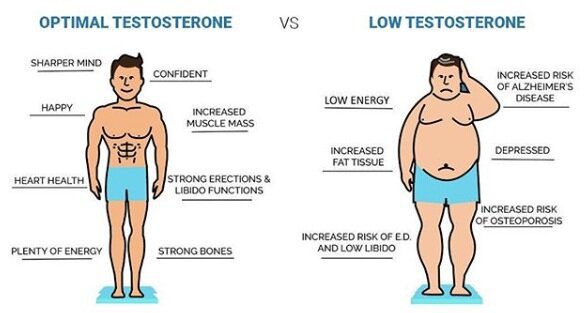The Rarely Shared Exercises That Give You Stamina For Hours

Table of Contents
Understanding the Importance of Stamina in Daily Life

Stamina, often overlooked in our fast-paced society, plays a crucial role in our daily lives. Whether it’s keeping up with the demands of a hectic work schedule, chasing after energetic children, or simply enjoying leisure activities, stamina is the key to meeting these challenges head-on.
The importance of stamina lies in its ability to sustain physical and mental energy levels, allowing us to perform tasks more efficiently and effectively. It is the endurance that keeps us going when faced with physical exertion or mental fatigue. Without stamina, we may find ourselves feeling drained, sluggish, and struggling to maintain focus and productivity throughout the day.
Incorporating stamina-building activities into our daily routines can reap numerous benefits in both our personal and professional lives. Not only does it enhance our overall physical fitness, but it also strengthens our mental resilience, enabling us to tackle daily challenges with greater ease. Moreover, studies have shown that individuals with higher stamina levels experience improved cardiovascular health, reduced risk of chronic diseases, and enhanced cognitive functions. Thus, understanding the importance of stamina becomes essential in optimizing our well-being and achieving a balanced and fulfilling life.
The Science Behind Building Endurance and Stamina

The science behind building endurance and stamina is rooted in the body’s physiological adaptations to prolonged physical exertion. When we engage in activities that require endurance, such as long-distance running or cycling, our cardiovascular system works in tandem with our muscles to supply oxygen and nutrients while removing waste products effectively. This process is facilitated through various mechanisms, including increased cardiac output, angiogenesis (formation of new blood vessels), and improved oxygen utilization by the muscles.
A key aspect of building endurance and stamina is enhancing our body’s ability to efficiently utilize energy sources. During prolonged physical activity, our muscles rely primarily on carbohydrates and fats for fuel. Through consistent training and proper nutrition, our body can adapt and store more glycogen, the storage form of carbohydrates, in our muscles and liver. Additionally, greater mitochondrial density in muscle cells allows for enhanced fat oxidation, enabling us to sustain longer periods of physical exertion without experiencing fatigue. By optimizing our body’s energy systems, we can significantly improve our endurance and stamina.
Key Factors Affecting Stamina Levels
The stamina levels of an individual are influenced by several key factors, including physical fitness, diet, sleep, and overall lifestyle choices. Firstly, regular physical activity plays a crucial role in building and maintaining stamina. Engaging in aerobic exercises such as jogging, swimming, or cycling not only improves cardiovascular health but also trains the body to endure longer periods of physical exertion. Additionally, incorporating resistance training exercises like weightlifting or bodyweight exercises helps to strengthen muscles and improve overall stamina.
Proper nutrition is another factor that significantly affects stamina levels. A well-balanced diet rich in carbohydrates, lean proteins, and healthy fats provides the necessary fuel for the body to perform optimally. Carbohydrates, especially complex ones like whole grains and fruits, are the primary source of energy during physical activities. Adequate protein intake aids in muscle repair and growth, enhancing endurance. Furthermore, staying hydrated is essential for maintaining stamina, as even mild dehydration can lead to decreased performance and fatigue. It is recommended to consume an adequate amount of water throughout the day, especially before, during, and after exercise.
Overall, it is evident that both physical fitness and proper nutrition are integral to improving and maintaining stamina levels. By making conscious choices to stay active and fueling the body with the right nutrients, individuals can equip themselves with the endurance necessary to tackle the challenges of daily life.
Exploring Lesser-Known Exercises for Building Stamina
To build stamina, most people typically think of activities like running, cycling, or swimming. While these exercises are certainly effective in boosting endurance, there are also several lesser-known exercises that can help enhance stamina levels. One such exercise is stair climbing. Climbing stairs engages multiple muscle groups, including the quadriceps, hamstrings, glutes, and calves, making it a great all-around endurance-building exercise. Incorporating stair climbing into your workout routine can improve both cardiovascular fitness and lower body strength, leading to increased stamina in everyday activities.
Another underrated exercise for building stamina is rowing. Rowing is a low-impact, full-body workout that targets various muscle groups, including the legs, back, arms, and core. This exercise not only strengthens muscles but also improves cardiovascular endurance. By incorporating regular rowing sessions into your fitness routine, you can improve your stamina and overall endurance levels. Additionally, rowing is a great option for those who may have joint pain or injuries as it puts minimal stress on the joints.
The Role of Cardiovascular Training in Increasing Endurance

Cardiovascular training plays a crucial role in increasing endurance levels, making it an essential component of any stamina-building program. Engaging in regular cardiovascular exercises not only improves the health of your heart and lungs but also enhances the efficiency of your body’s oxygen utilization, leading to improved endurance and stamina.
When you engage in cardiovascular exercises such as running, cycling, or swimming, your heart rate increases, and more oxygen-rich blood is pumped to your muscles. Over time, this repetitive stress on the cardiovascular system leads to adaptations such as an increase in the size and strength of the heart and an improvement in the efficiency of blood circulation. These adaptations result in improved endurance, as your body becomes better equipped at delivering oxygen to your muscles and efficiently clearing waste products such as carbon dioxide.
Moreover, cardiovascular training also stimulates the development of new blood vessels, a process known as angiogenesis, which further enhances oxygen delivery to the muscles. This increased oxygen supply allows for better energy production within the muscle cells, delaying the onset of fatigue and enabling you to sustain physical activity for a longer duration.
To maximize the benefits of cardiovascular training in increasing endurance, it is important to incorporate a variety of exercises and gradually progress in intensity and duration. Additionally, combining cardiovascular training with other forms of exercise, such as resistance training or interval training, can further enhance your overall stamina and endurance levels. With a well-rounded approach to cardiovascular training, you can unlock your body’s potential for long-lasting stamina and enjoy a higher level of endurance in your daily life.
Incorporating High-Intensity Interval Training (HIIT) into Your Routine
High-Intensity Interval Training (HIIT) is a popular exercise method that involves alternating periods of intense exercise with short recovery periods. This form of training has gained significant attention due to its effectiveness in improving endurance and stamina. Incorporating HIIT into your routine can be a great way to push your limits and enhance your overall fitness.
One of the key benefits of HIIT is its ability to improve cardiovascular health. The intense bursts of activity during HIIT sessions challenge your heart, causing it to work harder and become more efficient. This can lead to a stronger heart muscle and improved blood flow throughout the body. Additionally, HIIT has been shown to increase the VO2 max, which is a measure of the body’s ability to use oxygen during exercise. By improving this metric, HIIT can enhance endurance and stamina, allowing you to perform better in various physical activities.
When incorporating HIIT into your routine, it is important to start gradually and listen to your body. HIIT sessions can be demanding, and it is essential to give yourself enough time to recover between workouts. Additionally, it is crucial to ensure proper form and technique during high-intensity exercises, as incorrect form can increase the risk of injury. Consulting with a fitness professional or trainer can help you design a safe and effective HIIT program tailored to your fitness level and goals.
• Gradually increase the intensity: Start with shorter intervals of intense exercise and longer recovery periods, then gradually increase the duration and intensity as your fitness improves.
• Warm up properly: Before starting a HIIT session, make sure to warm up your muscles and joints to prevent injury. This can include dynamic stretching or light aerobic exercises.
• Include a variety of exercises: Incorporate different types of high-intensity exercises into your routine to target different muscle groups and keep your workouts interesting.
• Monitor your heart rate: During HIIT sessions, it is important to monitor your heart rate to ensure you are working at an appropriate intensity level. This can be done using a heart rate monitor or by checking for signs of exertion such as increased breathing or sweating.
• Allow for adequate recovery time: Give yourself enough time between HIIT workouts for proper rest and recovery. This will help prevent overtraining and reduce the risk of injury.
• Stay hydrated: Drink plenty of water before, during, and after your HIIT sessions to stay hydrated and maintain optimal performance.
• Listen to your body: If you experience any pain or discomfort during a HIIT workout, it is important to stop immediately and seek medical attention if necessary. Pushing through pain can lead to further injury.
By following these guidelines, incorporating high-intensity interval training (HIIT) into your routine can be a safe and effective way to improve cardiovascular health, endurance, stamina, and overall fitness. Remember that consistency is key when it comes to seeing results from any exercise program. So commit yourself fully but also remember that rest days are just as important in allowing your body time to recover from the intense workouts. With dedication and patience, you’ll soon reap the benefits of this challenging yet rewarding form of exercise!
Building Stamina through Resistance Training and Weightlifting
Resistance training and weightlifting are not only effective for building strength and muscle mass, but they are also essential for improving stamina and endurance. When performed correctly and with proper progression, these forms of exercise can have profound effects on overall fitness and stamina levels.
One of the primary mechanisms by which resistance training and weightlifting enhance stamina is by improving the efficiency of oxygen and energy utilization in the body. These activities increase both aerobic and anaerobic capacity, allowing the muscles to work harder and for longer durations. Furthermore, resistance training stimulates the development of slow-twitch muscle fibers, which are responsible for endurance activities.
In addition to improving oxygen utilization, resistance training and weightlifting also enhance muscular endurance. This means that the muscles become more fatigue-resistant, allowing individuals to perform daily tasks and physical activities with less effort and for longer periods. Moreover, these exercises strengthen the connective tissues and improve joint stability, reducing the risk of injury and allowing for more prolonged and intense training sessions.
To fully optimize stamina gains from resistance training and weightlifting, it is important to focus on compound exercises that engage multiple muscle groups simultaneously. Squats, deadlifts, bench presses, and overhead presses are examples of compound exercises that not only promote full-body strength but also increase cardiovascular endurance. Using progressive overload, where you gradually increase the weight or resistance over time, will also help to continually challenge the muscles and stimulate further stamina improvements.
Keep in mind that resistance training and weightlifting should be part of a well-rounded fitness routine that includes cardiovascular exercises, flexibility training, and proper nutrition. It is important to consult with a qualified fitness professional to design a personalized program that meets your specific needs and goals. By incorporating resistance training and weightlifting into your workouts, you can significantly enhance your stamina, endurance, and overall physical performance.
The Benefits of Plyometric Exercises for Endurance
Plyometric exercises, also known as jump training or plyos, have gained popularity for their ability to improve endurance and overall athletic performance. These dynamic movements involve explosive jumps and quick, powerful contractions of muscles, which can help increase stamina levels. By incorporating plyometrics into your training routine, you can reap several benefits that contribute to enhanced endurance.
One of the key advantages of plyometric exercises is their ability to improve cardiovascular fitness. These high-intensity movements require the heart and lungs to work harder, leading to increased oxygen consumption and improved aerobic capacity. Research has shown that plyometrics can lead to significant improvements in VO2 max, which is a measure of the maximum amount of oxygen your body can utilize during exercise. By enhancing your cardiovascular fitness with plyometric training, you can enhance your endurance levels, allowing you to sustain physical activity for longer periods.
In addition to improving cardiovascular fitness, plyometrics can also enhance muscular power and efficiency. The explosive nature of these exercises helps improve the muscle’s ability to generate force quickly, resulting in more efficient movement patterns. This increased power output can translate into improved endurance, as it allows you to maintain a higher intensity for extended periods. Furthermore, plyometrics engage multiple muscle groups simultaneously, leading to a more balanced and coordinated muscular development. This can not only improve overall athletic performance but also reduce the risk of injuries associated with muscle imbalances.
To maximize the benefits of plyometric exercises, it is crucial to incorporate them strategically into your training program. Consulting with a qualified fitness professional can help ensure that you perform these exercises with proper form and technique, minimizing the risk of injury. Additionally, gradually progressing the intensity and volume of plyometric training is essential to avoid overtraining and achieve optimal results. By integrating plyometrics into your endurance training regimen, you can enjoy a wide range of benefits that contribute to improved stamina and overall physical performance.
Unlocking Stamina with Functional Training and Bodyweight Exercises
Functional training and bodyweight exercises have gained significant popularity in recent years for their ability to improve stamina and endurance. These types of exercises focus on enhancing overall strength, flexibility, and agility, which are crucial elements in developing stamina. Functional training emphasizes movements that mimic real-life activities, such as squatting, lunging, pushing, and pulling, while bodyweight exercises utilize the individual’s own body weight as resistance. These exercises engage multiple muscle groups simultaneously, leading to increased cardiovascular capacity and improved stamina.
One of the benefits of functional training and bodyweight exercises is their versatility. They can be performed virtually anywhere, making them accessible to individuals of all fitness levels and ages. Moreover, they require little to no equipment, making them a cost-effective option for those looking to improve their stamina. Examples of functional training exercises include burpees, planks, mountain climbers, and kettlebell swings, while bodyweight exercises include push-ups, squats, lunges, and jump squats. Incorporating a variety of these exercises into your routine can help you build endurance and stamina while enhancing your overall fitness level.
It is important to note that functional training and bodyweight exercises should be performed with proper form and technique to prevent injury and maximize their benefits. To ensure the correct execution of these exercises, seeking guidance from certified fitness professionals or personal trainers is recommended. Additionally, it is crucial to progress gradually, gradually increasing the intensity, duration, and complexity of the exercises, as this will allow your body to adapt and improve over time. By incorporating functional training and bodyweight exercises into your fitness routine, you can unlock your full potential and achieve long-lasting stamina.
The Power of CrossFit and Circuit Training for Long-Lasting Stamina
CrossFit and circuit training are two popular workout methods that can significantly contribute to building long-lasting stamina. Both of these training approaches focus on high-intensity exercises, combining elements of strength training, cardiovascular conditioning, and overall functional fitness.
CrossFit, known for its intense and varied workouts, incorporates a mix of different exercises, including weightlifting, gymnastics, and cardio activities. These workouts are designed to push individuals to their limits, helping them improve their overall endurance and stamina levels. By engaging in a wide range of physical movements and pushing the body to adapt to varying intensities, CrossFit provides a comprehensive approach to building stamina.
On the other hand, circuit training involves performing a series of exercises with minimal rest periods in between. This form of training targets multiple muscle groups and enhances cardiovascular fitness by keeping the heart rate elevated throughout the workout. By alternating between different exercises and targeting various muscle groups, circuit training challenges both the cardiovascular and muscular systems, leading to improved stamina over time.
Both CrossFit and circuit training offer unique benefits when it comes to building stamina. It’s important to note that these workouts can be intense and may not be suitable for beginners or individuals with certain health conditions. As always, it is advisable to consult with a qualified fitness professional before starting any new training program to ensure it aligns with your fitness goals and capabilities.
Enhancing Stamina through Outdoor Activities and Sports
Outdoor activities and sports can provide a fun and effective way to enhance stamina levels. Engaging in these activities can not only improve physical fitness but also boost endurance and overall energy levels. Whether it’s running, cycling, swimming, or participating in team sports like soccer or basketball, these activities require sustained physical effort, which helps train the body to endure for longer periods.
One of the key benefits of outdoor activities and sports is that they offer a more dynamic and interactive experience compared to indoor exercises. The changing terrain, weather conditions, and social element of participating in sports can push individuals to test their limits and push through mental and physical barriers. Additionally, outdoor activities often require different movements and muscle groups, providing a well-rounded workout that targets various areas of the body. This multi-dimensional approach ensures overall fitness and helps build stamina in a more holistic manner. So, if you’re looking to enhance your stamina, consider incorporating outdoor activities and sports into your fitness routine.
Here’s a table-format discussion on enhancing stamina through outdoor activities and sports:
| Aspect | Description |
|---|---|
| Outdoor Activities | Engaging in outdoor activities such as hiking, cycling, running, swimming, and trekking promotes cardiovascular endurance, muscle strength, and overall stamina. These activities also offer mental relaxation and stress reduction. |
| Sports | Participating in sports like soccer, basketball, tennis, or rugby challenges the body’s endurance, agility, and coordination. Regular sports practice enhances cardiovascular fitness, muscular endurance, and stamina levels. |
| Interval Training | Interval training involves alternating between high-intensity bursts of activity and periods of rest or low-intensity exercise. This training method improves aerobic capacity, endurance, and metabolic efficiency, enhancing overall stamina. |
| Cross-Training | Cross-training involves incorporating a variety of activities and sports into your fitness routine. It prevents boredom, reduces the risk of overuse injuries, and provides a comprehensive workout that targets different muscle groups and energy systems. |
| Strength Training | Strength training complements endurance activities by building muscular strength, power, and endurance. Incorporating resistance exercises using weights, resistance bands, or bodyweight improves overall stamina and athletic performance. |
| Proper Nutrition | Fueling your body with a balanced diet rich in carbohydrates, proteins, healthy fats, vitamins, and minerals supports optimal energy levels, endurance, and recovery. Adequate hydration is also essential for maintaining stamina during outdoor activities and sports. |
| Rest and Recovery | Prioritizing rest and recovery is crucial for enhancing stamina and preventing burnout or overtraining. Ensure adequate sleep, practice relaxation techniques, and listen to your body’s signals to avoid fatigue and optimize performance. |
The Impact of Proper Nutrition and Hydration on Stamina Levels
Proper nutrition and hydration play a crucial role in maintaining optimal stamina levels. The food we eat and the fluids we consume directly impact our energy levels, endurance, and overall performance. A well-balanced diet that provides essential nutrients, vitamins, and minerals is essential for sustaining stamina throughout the day.
When it comes to nutrition, it is important to fuel your body with a variety of nutrients. Adequate intake of carbohydrates, proteins, and healthy fats is vital for energy production and muscle repair. Complex carbohydrates, such as whole grains and legumes, provide a steady release of energy, while proteins contribute to muscle strength and recovery. Including vegetables, fruits, and sources of omega-3 fatty acids, such as fish and nuts, can help reduce inflammation and support overall stamina.
In addition to a balanced diet, proper hydration is equally important for optimal stamina levels. Dehydration can lead to fatigue, decreased alertness, and poor physical performance. It is recommended to drink water throughout the day, aiming for at least eight glasses or more, depending on individual needs. Hydration can also be obtained from healthy beverages such as herbal teas, infused water, and low-sugar sports drinks.
In conclusion, the impact of proper nutrition and hydration on stamina levels cannot be overlooked. Consuming a well-rounded diet and staying adequately hydrated are essential for sustaining energy, enhancing endurance, and performing at your best. By prioritizing these factors, individuals can unlock their full potential and achieve long-lasting stamina in their daily lives.
Strategies for Rest and Recovery to Optimize Stamina
Rest and recovery are crucial components of any stamina-building program. In order to optimize stamina levels, it is essential to prioritize adequate rest and recovery periods. When the body is pushed to its limits during intense training sessions, rest periods allow for the repair and regeneration of tissues, helping to prevent overuse injuries and improve overall stamina.
One effective strategy for rest and recovery is to incorporate regular rest days into your training schedule. These rest days provide an opportunity for the body to recover and adapt to the stresses of exercise. It is advisable to schedule at least one or two rest days per week, depending on the intensity and duration of your training sessions. During these rest days, engaging in low-impact activities such as walking, yoga, or stretching can help promote blood flow, reduce muscle soreness, and aid in the recovery process. Additionally, getting sufficient sleep is vital for optimal recovery and stamina. Aim for seven to nine hours of quality sleep each night, as sleep deprivation can negatively impact stamina levels and overall performance.
While rest is important, active recovery can also play a significant role in optimizing stamina. Active recovery refers to low-intensity exercises or activities performed in between intense training sessions. Engaging in activities such as swimming, cycling, or light jogging can help boost blood circulation, flush out metabolic waste products, and facilitate the healing process of overworked muscles. Active recovery should be performed at a low intensity and should not lead to additional fatigue. It is important to listen to your body and adjust the intensity and duration of active recovery activities accordingly. Remember, rest and recovery are not signs of weakness, but rather essential components of a well-rounded stamina-building program.
Creating a Personalized Stamina-Building Program: Tips and Considerations
When it comes to creating a personalized stamina-building program, there are several important tips and considerations to keep in mind. Firstly, it is crucial to assess your current level of fitness and stamina in order to establish a baseline. This can be done through various tests such as the Cooper Test or the Rockport Walk Test, which measure cardiovascular endurance.
Once you have determined your starting point, it is important to set realistic goals for yourself. These goals should be specific, measurable, attainable, relevant, and time-bound (SMART goals). For example, you may aim to improve your running endurance by being able to run for 30 minutes continuously within 8 weeks.
In order to build stamina effectively, it is essential to incorporate a variety of exercises into your routine. This includes cardiovascular exercises such as running, swimming, or cycling, as well as resistance training and weightlifting. High-intensity interval training (HIIT) can also be a highly effective method for increasing stamina, as it combines short bursts of intense exercise with brief recovery periods.
In addition to exercise, proper nutrition and hydration play a crucial role in optimizing stamina levels. A well-balanced diet, rich in carbohydrates, protein, and healthy fats, will provide the energy needed for endurance activities. It is also important to stay properly hydrated before, during, and after exercise, as dehydration can significantly decrease stamina.
Rest and recovery are equally important factors to consider when building stamina. Allowing your body enough time to recover between workouts is crucial for preventing injuries and maximizing performance. Incorporating rest days into your training program and ensuring an adequate amount of sleep each night will help your body repair and regenerate, ultimately leading to improved stamina.
In conclusion, when creating a personalized stamina-building program, it is crucial to assess your current fitness level, set realistic goals, incorporate a variety of exercises, focus on proper nutrition and hydration, and allow for adequate rest and recovery. By following these tips and considerations, you can develop a program that is tailored to your individual needs and helps you to progressively improve your stamina over time.
Why is stamina important in daily life?
Stamina is important in daily life as it allows us to sustain physical and mental effort for extended periods. It helps us perform tasks efficiently, reduces fatigue, and improves overall productivity and quality of life.
What factors affect stamina levels?
Several factors can affect stamina levels, including genetics, age, overall health and fitness, nutrition, hydration, sleep patterns, and the level of physical activity.
How does cardiovascular training help in increasing endurance?
Cardiovascular training, such as running, swimming, or cycling, improves stamina by strengthening the heart and lungs, increasing oxygen delivery to muscles, and improving the body’s ability to use oxygen efficiently. This leads to enhanced endurance and improved stamina.
What is High-Intensity Interval Training (HIIT)?
High-Intensity Interval Training (HIIT) is a form of exercise that alternates between short bursts of intense activity and periods of rest or low-intensity exercise. It has been shown to effectively improve stamina, burn calories, and boost cardiovascular fitness.
How can resistance training and weightlifting help in building stamina?
Resistance training and weightlifting can help build stamina by increasing muscle strength and endurance. This, in turn, allows the muscles to work for longer periods without fatigue, leading to improved stamina and overall physical performance.
What are plyometric exercises and how do they benefit endurance?
Plyometric exercises involve explosive movements that rapidly stretch and contract muscles. These exercises, such as jump squats or box jumps, help improve muscular power and efficiency, leading to enhanced endurance and stamina.
What is functional training and how does it help in building stamina?
Functional training involves exercises that mimic real-life movements and improve overall strength, flexibility, and coordination. By training the body to perform daily tasks more efficiently, functional training enhances stamina and endurance.
How does CrossFit and circuit training contribute to long-lasting stamina?
CrossFit and circuit training combine high-intensity exercises with short rest periods, providing a full-body workout that targets various muscle groups and cardiovascular fitness. These training methods are highly effective in improving stamina and developing long-lasting endurance.
Can outdoor activities and sports help enhance stamina?
Yes, outdoor activities and sports such as hiking, biking, swimming, or team sports can greatly enhance stamina. They provide an enjoyable way to engage in physical activity, challenge the body, and improve overall endurance levels.
How does nutrition and hydration impact stamina levels?
Proper nutrition and hydration play a crucial role in maintaining and enhancing stamina levels. Consuming a balanced diet rich in carbohydrates, proteins, and healthy fats, along with staying adequately hydrated, provides the necessary fuel and nutrients for optimal stamina and performance.
What strategies can be employed for rest and recovery to optimize stamina?
Adequate rest and recovery are essential for optimizing stamina. Strategies such as incorporating rest days into the training program, prioritizing quality sleep, practicing relaxation techniques, and engaging in activities that promote mental and physical rejuvenation can help prevent burnout and improve stamina levels.
How can I create a personalized stamina-building program?
To create a personalized stamina-building program, consider factors such as your current fitness level, goals, time availability, and preferences. Gradually increase the intensity and duration of exercises, choose a variety of training methods, monitor progress, and make necessary adjustments to continually challenge yourself and improve stamina. It is also advisable to consult with a fitness professional for personalized guidance and support.






